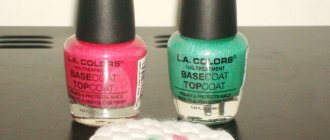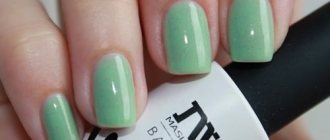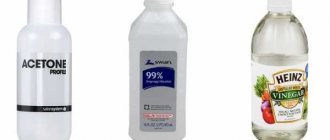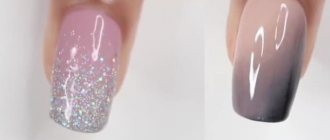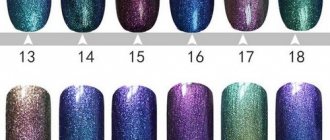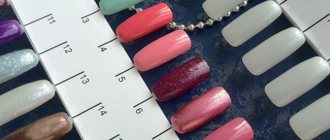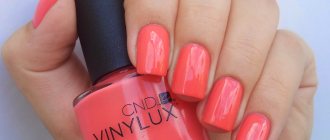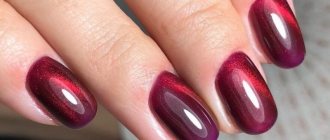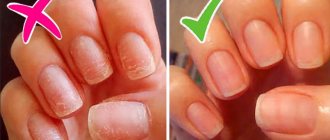Many people have a question: is it possible to mix gel polishes from different companies?
Experienced craftsmen say that it is recommended to mix varnishes from the same manufacturer; this will give a more predictable result. But experiments with varnishes from different companies can also be carried out.
- It is better to mix colors a few drops on the palette to save on material.
- Drop a little of one color and another, mix and see what shade you get.
- If you are satisfied with it, use varnishes in large proportions so that they are convenient to apply to your nails.
- Write down or take a photo of exactly what tones you mixed so that you can repeat the procedure next time if necessary.
Is it possible to mix gel polishes, how to get a new shellac color
You can mix gel polishes. It is in this way that many masters can realize any client’s wishes without extra costs, making do with a limited number of colors, textures and effects of gel polishes. Getting a unique shade is not difficult; it is enough to have a maximum of 10 colors. However, in order to guarantee durability of the manicure and safety for the client, it is necessary to adhere to some mandatory rules for mixing shellac and gel polishes.
The recommendations are as follows:
- It is not advisable to mix coatings from different brands and companies. Since manufacturers produce paints and varnishes using various technologies, there is no guarantee that the synthesis of different materials will polymerize well and will be durable (not to mention the risk of an allergic reaction);
- It is permissible to mix paints of the same brand, obtaining new and interesting shades. Depending on your skill level, you can do this either on the nail itself (applying colors in layers), or by mixing the material for all fingers on the palette at once.
- After mixing the colors, keep the mixture away from sunlight and the glow of manicure polymerization lamps;
- It is better to create new colors by trusting reliable brands, the less the risk of sediment forming in the mixture or changing color during wear;
- do not mix large volumes at once, experiment drop by drop without transferring the material (which is especially important for expensive, branded gel polishes);
- It is best to prepare the mixture in an opaque container (closed palette or jar). If there is a large flow of clients, you can use the remains of the batch for painting in one design or another;
- The following colors must be in your manicure arsenal: black, white, blue, green, red and yellow. To create variations with a shimmering effect, also purchase gel polishes with gold and silver sparkles.
Practicing manicurists highlight the following useful recommendations for mixing gel polishes and shellacs:
- It is best to combine enamels with each other, since their rich pigmentation usually covers microglitters and mother-of-pearl.
- When mixing colors for all nails, do the mixture on all fingers at once, and not for each separately. Unless of course you want to create a gradient effect from the little finger to the thumb. The disparity of light looks ugly and not expressive.
- It is best to test the manufactured color before the client on a tip or palette, polymerize it in a lamp and cover it with a top coat of the same brand. Check out the results under different lights. If you like all the options, you can offer the client an experiment. In order not to forget what colors this or that mix consists of, masters practice applying droplets of color to a chamomile palette or display under the result nail. This cheat sheet is especially convenient to use when there is a fairly large number of different coatings from the same manufacturer.
Is it possible to mix gel with acrylic paints?
Another way to add zest to your manicure is to mix gel and acrylic paint. True, there is no exact formula, so you can achieve a high-quality result only through experimentation.
The fact is that all gels react differently to interaction with acrylic; they can curl up to the consistency of plasticine, which in this form is not at all suitable for work.
In order not to spoil the material, try mixing a drop of gel with eye shadow or powder and see what the result is.
Mixing these two components affects the structure of the material into which the foreign object has fallen, but most often the experiments still end successfully.
If you are concerned about the question of whether it is possible to mix gel with acrylic powder , then you can safely do so.
Craftsmen successfully combine these two materials, making a colored base using gel polish, then applying acrylic powder and design elements.
Can the gel be mixed with regular nail polish?
The unique gel material can be mixed not only with acrylic, but also with conventional varnishes.
This will come in handy when creating an unusual design and in cases where you don’t have the right color gel on hand. True, there are some subtleties here too.
Not recommended:
- Applying regular polish to gel without removing the sticky layer. This leads to a mixture of the two compositions, and the manicure will not last long.
- Applying a simple varnish between the base and top. In this case, the top coat will not adhere well and will quickly fall off with or without varnish.
How to make a milk base for nails?
For several years now, the milk base has been winning the hearts of nail service professionals, their clients and just people who love beautiful nails. Finding and buying a milk base is now not difficult; almost all brands of gel polish materials produce such material. But not everyone, for example, now has the opportunity to buy such a database, or, for example, they need it urgently and right now. Surely everyone has the most common transparent base. So you can easily make the milk base yourself. To do this you need a transparent base and white gel polish.
Take our transparent base and drop, for example, onto the palette as much as you need for your work. And add a little white gel polish into this base. You only need a little bit of it so that the color of the material turns out not white and dense, but semi-transparent. Mix well and look at the color and consistency. You can add more white gel polish, the main thing is just not to overdo it. Instead of white gel polish, you can add just a little white gel paint, just a little. Because it is highly pigmented and can spoil our future milk base. The result will be not a milk base, but a white gel polish. You need to mix our base quietly and carefully, otherwise you can blow a lot of bubbles into it.
Next, we take a separate flat brush and apply our mixed milk base with it. If necessary, we help it to be well distributed near the cuticle and near the side rollers with a thin brush. Some people apply a thin layer of regular transparent base underneath the milky base; I personally apply the milky base right away. I just first prepare the nail plate well - manicure, degreasing (you can even do it several times), trim the cuticle and file the shape. I apply a dehydrator (not always), and a primer is a must. I let it air dry for about a minute. Then, first, I apply our milk base in a thin layer, place a larger drop closer to the cuticle, and retreat a few millimeters. And I stretch the base to the tip of the nail. At the same time creating the correct architecture and apex of the nail. I dry it for at least a minute in the lamp. If you have a UV lamp, you need to dry for 2-3 minutes. The milk base needs to be dried longer than the usual transparent one, because it may not dry out on you. Milk base is a color base because it contains pigment. If desired and necessary, if, for example, some bald spots are visible on the nail plate, you can apply a second layer of milk base. Of course, after the first layer has dried thoroughly.
In the same way as the milk base, you can make a milk gel. Simply by mixing white gel with white gel polish.
Manicure
Gel polish is not subject to abrasion and is not afraid of the effects of household chemicals, which is why many people use it for manicures. Girls often buy UV lamps so as not to spend money on expensive salon treatments and take care of their nails at home. A home manicure turns out to be much cheaper, because for this you just need to purchase all the necessary materials, but you will also have to practice, because you won’t get a beautiful manicure right away. But the salon offers a large selection of color shades and all kinds of patterns, which will be very difficult to do on your own.
But a way out can always be found. The girls decided to experiment and see if it was possible to mix the colors of gel polishes, thus getting
new colors without buying new paints.
When asked whether it is possible to mix gel polishes from different companies, manicurists answer unequivocally: it’s not worth it. It is better to do this with paints of the same brand, so initially you should buy paints from the same manufacturer, then there will be no problems. But still, no one forbids experimenting. To do this, it is better to mix slightly different colors in the palette to understand whether the new shade suits you or not. If the color turns out beautiful, you can combine them in large quantities and make a manicure, otherwise you won’t mind spending a few drops.
That's right, even using several paints, you can create a new color palette without buying new ones.
We recommend:
Gel polish Tango - a product for non-professional use
What is the difference between gel paint and gel polish, are they interchangeable?
Although gel paint and gel polish have a base made of the same material (gel), these concepts are by no means identical. Their main difference is their purpose. Gel polish is a durable coating for the nail plate, combining the properties of a strengthening and decorative material. Gel paint, in turn, is necessary for creating designs on nails, that is, exclusively for decorating them. Other differences in materials follow from the difference in purpose:
- consistency. Gel polishes are more liquid, as they are needed to create a uniform coating, and paints are thicker, which allows you to create beautiful, even lines;
- degree of pigmentation. The paint is applied mainly in one layer and immediately gives a clear color, while to create a dense color coating with varnish, 2 layers are often required;
- output volumes. Taking into account the consumption of material for its intended purpose, gel paints are produced in smaller volumes. For example, Canni gel paint is popular due to its good price-quality ratio. It is packaged in 5 ml, while gel polishes from the same company are 7.3 ml. You can buy Kanny gel paint at the ShellNail store.
You can often find information that gel paints and varnishes are interchangeable, and both materials can be used for painting and for coating the plate. Given the same basis, this is theoretically possible, but the question is different - is it necessary? Each of the materials was developed to solve a specific problem, which means its properties are ideal for its purpose. Related use is possible, but the result will not be ideal.
